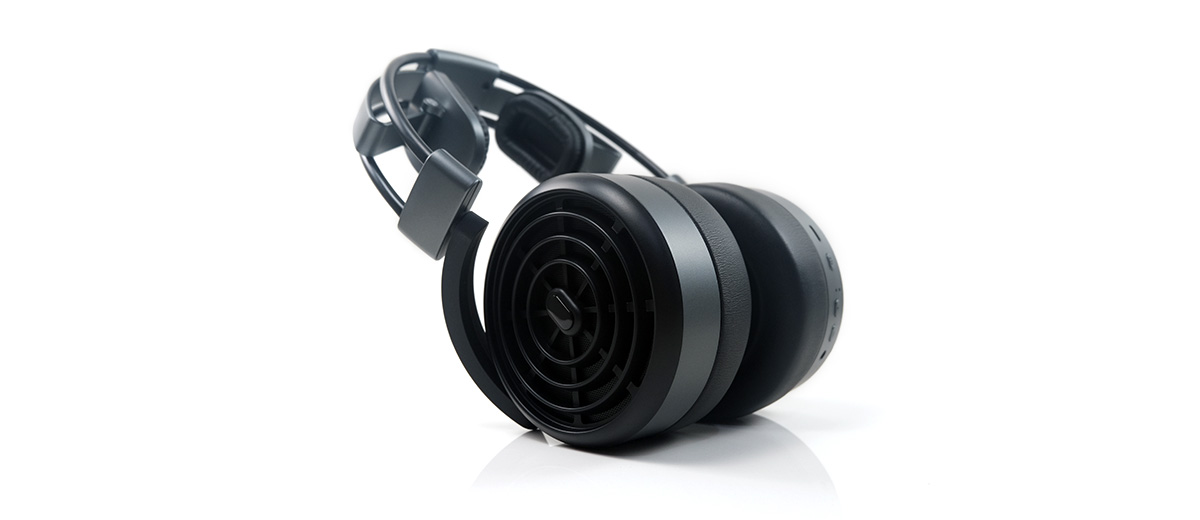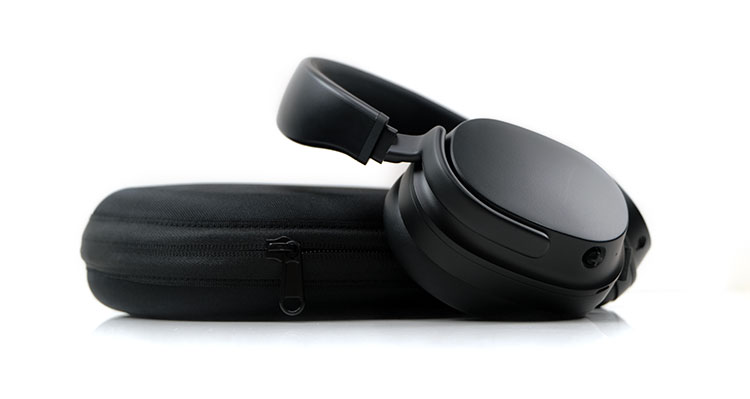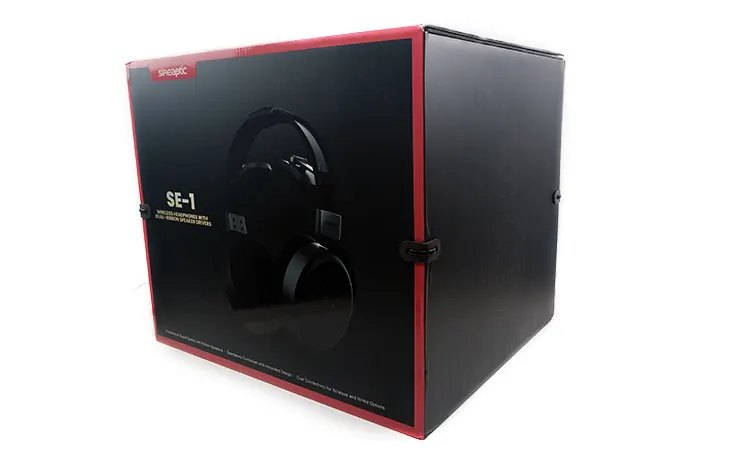Select Comparisons
The following comparisons were done primarily in wireless mode with some additional commentary for their wired performance using a Rupert Neve Designs RNHP and a FiiO K9 Pro ESS integrated DAC and headphone amplifier.
HIFIMAN Deva Pro Wireless
The HIFIMAN Deva Pro Wireless was launched in mid-2022 with our review coming out not long after. It also won our Bang For Buck Editor’s Choice Award for that same year.
Technical
Both headphones are open-back, however, the Deva Pro uses a super-thin NEO “supernano” diaphragm, (NSD) planar design as opposed to the dual ribbon array inside the SE-1.
Although different approaches magnets are central to the efficiency and even response of both diaphragms with both drivers using N52 Neodymium magnet arrays.
The Deva Pro also uses HIFIMAN’s Stealth Magnet array implementation. This is a magnet array with different physical shapes and compositions to allow sound waves to pass through from one side to another without creating any “interferences” such as wave diffraction turbulence and lowering distortion in the process.
Their wireless implementation is also quite different with the Deva Pro using a detachable wireless BT amp and DAC called the Bluemini and the SE-1 integrated into the cup.
In its current iteration, this is a HYMALAYA chipset which is HIFIMAN’s own in-house R2R-type decoding technology flanked by a BT5.2 Qualcomm QCC5124 chipset with codec decoding capability ranging from SBC/ACC up to LDAC and including aptX-HD.
The SE-1 wireless capability is also BT5.2 capable and whilst there is no mention of the specific chipset it is listed as having a more limited SBC and ACC decoding capability. It does though have a much better battery life performance at roughly 15 hours over the Bluemini’s 8 hours rating.
Design
I think the Deva Pro is the better design but with a level of material quality that’s largely similar to the SE-1. When I say better design it’s simpler, less fussy, and with cleaner lines. The Deva Pro also weighed less at 360g compared to 410g.
There are fewer jutting parts that could be accidentally broken on the Deva Pro frame whereas the small articulating wing pads and retaining block on the SE-1 headband might be some areas that would concern me for longevity.
The bigger SE-1 also clamps a bit a bit looser so it is not as secure on your head but the pads are a little comfier than the Deva Pro. Perhaps a slightly softer outer or memory foam inner combined with a larger inner pad opening helps the SE-1.
If you are planning to go wired then the Deva Pro’s supplied cable quality is better than the aux cable that comes with the SE-1.
The Deva Pro is a proper dual-entry headphone cable design and with a detachable BT module, it means you can use it passively. Whereas the SE-1 cannot bypass the internal amplifier so you will eat battery hours even if being used with an amplifier.
Just to note though, to get wireless functionality on the Deva Pro the price jumps from $130 from $199 to $329 SRP so those advantages for the Deva Pro come at an additional cost.
Performance
Fairly different curves here though I do find aspects of both headphones’ midrange imaging to be relatively similar.
The SE-1 is more V-shaped than the Deva Pro with a lot more treble presence and extension, particularly from 6-10k onwards. The Deva Pro is more sedate and controlled over the same region which in turn robs it a little of comparative sparkle and extension allowing the mids to dominate a bit more.
The SE-1’s mids are thinner sounding with more treble coloration giving it a very clean and at times a more articulate and deeper quality, but the lack of warmth in the mids might jar on brighter mixes and percussion timbre.
The Devo Pro is fuller sounding, more rounded, and smoother through the mids with stronger lower-mids presence and instrumental body. The better body has a more immediate feel with the perception of a more intimate soundstage despite my feeling that the vocal imaging is not too dissimilar between the two.
The SE-1 does have more of a bass hump than the more linear Deva Pro bass response though I find the SE-1 bass lift a bit disconnected and slightly soft in its definition. The ‘hump’ is tighter and better defined when the SE-1 is in wired mode from the likes of the K9 Pro ESS and the RNHP amplifier.
Still, overall, there is a better sensation of depth from the SE-1 whereas the Deva Pro is a lot flatter below 80Hz giving it more of an upper-bass to lower-mids staging bias.
Drop + THX Panda
We never actually reviewed the Drop + THX Panda though we have had it in the office for quite some time and have referred to it in previous reviews. It was launched by Drop back in 2020 and at the time was one of the more unique wireless headphone creations.
Technical
Most people who know the Panda will define it similarly to the Deva Pro as a set of planar magnetic driver headphones with wireless capability housed in a closed-back small circumaural form factor as opposed to the SE-1 larger circumaural open-back design.
However, the Panda is a planar-ribbon driver which is a slightly different design to both a ribbon array and a standard planar headphone driver.
Those with a long memory will remember Igor Levitsky who worked with Oppo Digital to produce the PM-1, PM-2, and the very popular portable PM-3 headphones. Oppo Digital closed down a little while after with the IP up for grabs.
The PM-3, I believe, was one IP that became the basis for the Panda but the planar-ribbon tech was inherent in all 3 headphones. The ribbon description comes from its diaphragm which consists of a thin sheet of flexible transparent film with flat electrical conductors used to charge the diaphragm.
For Bluetooth, the Panda uses a lower BT5.0 protocol as opposed to the SE-1’s more modern BT5.2 but both have multi-point capability. The Panda also offers a higher LDAC decoding capability at up to 24BIT/96kHz wirelessly.
The two headphones can also be operated in a wired mode though the Panda will operate in passive mode whereas the SE-1 cannot bypass the internal amplifier so it’s strictly an active mode device. Battery life on the Panda is superior at 27-30 hours of battery life.
Design
The Panda has that classic PM-3 large supraaural small circumaural form factor with a very minimalist aesthetic.
It is a far cry from the more flamboyant design of the SE-1, though I dare say probably a slightly higher quality of finishing with both lateral and some limited vertical articulation in the cups.
The clamping is tighter with a neater opening on those smaller cups. It does stay more securely on your head compared to the SE-1 but it’s not as comfortable once you start doing some longer listening sessions.
The minimalism extends further with every single control function of the Panda housed in one single joystick nestled at the base of the right cup. Again, this is a preference thing because the learning curve as to the functions of the stick might be higher than the SE-1’s simpler array of buttons doing different things.
Both rock a 3.5mm SE jack with a fairly bland rubber short cable to go along with it. It’s a bonus cable but they will both work with better cables if you fancy trying to improve the dynamics in wired mode.
Neither have ANC but the closed-back design of the Panda will do better for isolation and should be seen as the more portable-friendly of the two headphones with that smaller form factor. The SE-1 does much better for long listening sessions at home in quieter environments.
Performance
You can tell right away the Panda is a closed back with that signature bass bloom that enclosed acoustical designs so often deliver.
The SE-1 does sound more open, and more spacious, and combined with that articulate ribbon array driver it also has a more articulate cleaner tone that helps with nuanced peripheral imaging presence.
Its treble is far more extended and energetic compared to the Panda making the Drop tuning sound relatively dark and bottom weighted.
However, the Panda does mids better for me, at least in terms of presence and body with LDAC improving the resolution. It’s a warmer and slightly softer timbral coloration with a longer bass shelf and a more elevated 1-4k region bringing vocals to the fore.
This is a rich and creamy tone, very nice for easy listening with little in the way of harmonic dissonance. It would be hard to find these headphones a fatiguing listening experience.
The SE-1 is the complete opposite with a V-shaped and more distant set of mids, cooler in tone, more likely to hear sibilance, or deliver an omnipotent steeliness in terms of midrange coloration.
It does well with recordings that are inherently warm or with husky soulful vocals, at least in terms of air and space but for bright clean head vocals it can be too thin and shrill.
The Panda is more forgiving but that closeness in its staging and warmth can sound a bit restrictive or comparatively congested, especially if that elongated bass shelf gets moving at the same time.
I would pick the Panda for vocal intimacy, body, and good midrange weight but I would pick the SE-1 for more expansive recordings where I need a more open and spacious sound quality.
HIFIMAN Ananda BT
The HIFIMAN Ananda BT was one of HIFIMAN’s first big-time wireless headphone releases back in 2020 and is notable for also having an open-back design much like the SE-1. Although its SRP was much higher than the SE-1, it can often be found under $500 these days.
Technical
The Ananda BT is a set of open-back circumaural planar driver headphones as opposed to the dual ribbon array inside the SE-1. That places it in line with the Deva Pro in terms of the use of their Neo “supernano” diaphragm though it’s from the older v1 Ananda rather than the newer Stealth Magnet revisions.
Like the SE-1, the Bluetooth functionality is integrated into the Ananda cups. It uses a Qualcomm CSR8675 receiver and can decode up to LDAC and HWA-LHDC 24BIT/96kHz levels as opposed to just SBC and AAC from the SE-1.
That being said the SE-1 does benefit from being a newer release with BT5.2 capability as opposed to the Ananda BT’s older BT5.0 protocol.
Both drivers are powered with an internal amplifier which is Class D for the SE-1 but no precise classification for the Ananda BT. HIFIMAN has no mention of Class for the Ananda BT other than it is a balanced amplifier design.
You can also use the Ananda BT in USB-DAC mode with a USB-C to USB-A cable directly from your PC which is not possible with the SE-1. Neither headphones’s amplifier can be bypassed for passive amplification when going wired so you are limited here for battery life.
And battery life is where the SE-1 has an advantage at around 15-25 hours depending on the wired AUX or wireless mode chosen whereas the Ananda BT battery life is nothing special at 10 hours max and slightly less at a full LDAC decoding rate. Both charging times are similar at roughly 3 hours each.
Design
It’s a classic HIFIMAN Ovoid design symbolic of their mid-to-high-end range of headphones. The cups are bigger than the SE-1 but the headband is lower-profile giving it a somewhat bottom-heavy visual whereas the SE-1’s elongated 3D wing system and arching headband design makes it look taller.
The finishing and materials are of a higher standard on the Ananda BT but that is to be expected for what is a more expensive headphone.
Comfort-wise is a few grams heavier than the SE-1 but it’s steadier on the head with a better pressure balance from its accompanying pressure strap. The SE-1’s weaker clamp can seem more comfortable though on the ear but the vertical pressure distribution is unbalanced with the weaker 3D wings system.
The control system is somewhat similar but critically the Ananda BT has no onboard volume control from the headphones. That limits the Ananda BT’s usefulness in terms of operating the headphones far away from the transmitting source and is an advantage for the SE-1.
The Ananda BT does have an app made by HIFIMAN but it’s quite limited. It allows you to check for firmware updates and install them but there is no ability to tweak control systems or built-in macro EQ systems.
Performance
The SE-1 is up there with the Ananda BT in terms of speed. Both of these drivers have a nice turn of pace with excellent articulation though a lot of the SE-1’s strength lies in its very clean and clear treble extension whereas the Ananda BT’s FR is more balanced and feels snappy throughout.
The key area for the Ananda BT and one which shows its superiority when compared to the SE-1, is its impact and solidity in the midrange.
The scoop in the SE-1 mids gives it a much thinner sound quality with the energy pushed more to the peripherals. It sounds equally as wide, if not more so when compared to the Ananda BT but it can also sound hollower and cooler in the mids.
The Ananda BT also has some mild bumping in the bass, not quite to the same extent as the SE-1 which will sound fuller on pop and R’n’B. However, it has a much better 2-4k presence so vocals are front and center benefiting from less bleed coming down from a gentler treble tuning.
If you do want treble brilliance and sparkle the SE-1 will give you a lot more from 5k upwards but that can have its downsides with a far sharper sounding higher-pitching vocal and percussion coloration.
The dynamic range on the Ananda BT is more noticeable when using LDAC where the nuanced detail is better fleshed out. Even so, when multipointing these both and dropping down to SBC, the Ananda BT driver still sounds more refined.
Our Verdict
The Sineaptic SE-1 is an ambitious release. Combining wireless with ribbon array drivers in an open-back design at a relatively affordable price point is a first but it’s a first with pros and cons.
It sounds clean, clear, and very articulate with an impressive turn of pace, reminding me of some older electrostatic headphone performances. Its wireless mode has excellent stability and good range and it’s fairly comfortable for long listening sessions.
However, its tuning is treble dominant in part, and though full in the bass, it is slightly loose in wireless mode with a thin midrange to go along with it. It also lacks LDAC or aptX codecs.
To be honest, I thought the driver held up quite well using both SBC and AAC modes. This was more of a case of wondering how much better it could be with superior codecs at its disposal. Battery life does enjoy those lower codecs though.
Overall, a very interesting set of wireless headphones offering something very new to the market with some pros and cons and all suspended inside a huge retail box for not a huge amount of greens.
Sineaptic SE-1 Technical Specifications
- Type: Over-ear, closed-back
- Driver Diameter: 50mm
- Frequency Response: 20Hz – 20kHz
- Wireless Version: 5.2
- Wireless Range: Up to 10 meters
- Battery Life: Up to 25 hours
- Charging Time: 3 hours
- Charging Type: Type-C USB
- Cable Length: 3 meters (3.5mm audio cable)
- Connectivity Technology: Wireless, 3.5mm stereo mini-plug
- Product Dimensions: 250 x 140 x 115mm
- Weight: 412g





